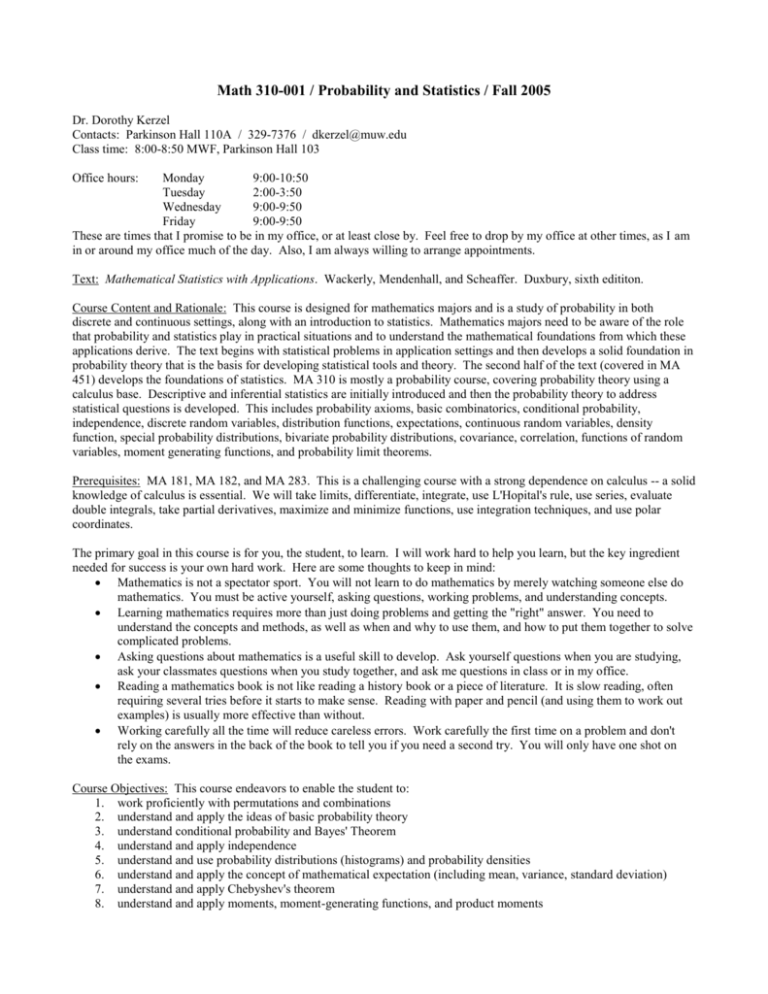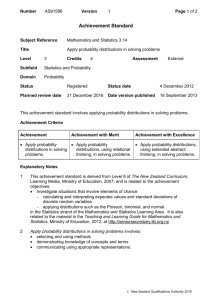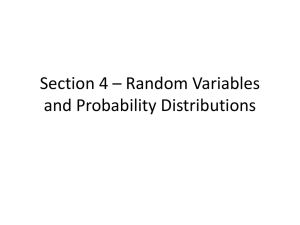Syllabus
advertisement

Math 310-001 / Probability and Statistics / Fall 2005 Dr. Dorothy Kerzel Contacts: Parkinson Hall 110A / 329-7376 / dkerzel@muw.edu Class time: 8:00-8:50 MWF, Parkinson Hall 103 Office hours: Monday 9:00-10:50 Tuesday 2:00-3:50 Wednesday 9:00-9:50 Friday 9:00-9:50 These are times that I promise to be in my office, or at least close by. Feel free to drop by my office at other times, as I am in or around my office much of the day. Also, I am always willing to arrange appointments. Text: Mathematical Statistics with Applications. Wackerly, Mendenhall, and Scheaffer. Duxbury, sixth edititon. Course Content and Rationale: This course is designed for mathematics majors and is a study of probability in both discrete and continuous settings, along with an introduction to statistics. Mathematics majors need to be aware of the role that probability and statistics play in practical situations and to understand the mathematical foundations from which these applications derive. The text begins with statistical problems in application settings and then develops a solid foundation in probability theory that is the basis for developing statistical tools and theory. The second half of the text (covered in MA 451) develops the foundations of statistics. MA 310 is mostly a probability course, covering probability theory using a calculus base. Descriptive and inferential statistics are initially introduced and then the probability theory to address statistical questions is developed. This includes probability axioms, basic combinatorics, conditional probability, independence, discrete random variables, distribution functions, expectations, continuous random variables, density function, special probability distributions, bivariate probability distributions, covariance, correlation, functions of random variables, moment generating functions, and probability limit theorems. Prerequisites: MA 181, MA 182, and MA 283. This is a challenging course with a strong dependence on calculus -- a solid knowledge of calculus is essential. We will take limits, differentiate, integrate, use L'Hopital's rule, use series, evaluate double integrals, take partial derivatives, maximize and minimize functions, use integration techniques, and use polar coordinates. The primary goal in this course is for you, the student, to learn. I will work hard to help you learn, but the key ingredient needed for success is your own hard work. Here are some thoughts to keep in mind: Mathematics is not a spectator sport. You will not learn to do mathematics by merely watching someone else do mathematics. You must be active yourself, asking questions, working problems, and understanding concepts. Learning mathematics requires more than just doing problems and getting the "right" answer. You need to understand the concepts and methods, as well as when and why to use them, and how to put them together to solve complicated problems. Asking questions about mathematics is a useful skill to develop. Ask yourself questions when you are studying, ask your classmates questions when you study together, and ask me questions in class or in my office. Reading a mathematics book is not like reading a history book or a piece of literature. It is slow reading, often requiring several tries before it starts to make sense. Reading with paper and pencil (and using them to work out examples) is usually more effective than without. Working carefully all the time will reduce careless errors. Work carefully the first time on a problem and don't rely on the answers in the back of the book to tell you if you need a second try. You will only have one shot on the exams. Course Objectives: This course endeavors to enable the student to: 1. work proficiently with permutations and combinations 2. understand and apply the ideas of basic probability theory 3. understand conditional probability and Bayes' Theorem 4. understand and apply independence 5. understand and use probability distributions (histograms) and probability densities 6. understand and apply the concept of mathematical expectation (including mean, variance, standard deviation) 7. understand and apply Chebyshev's theorem 8. understand and apply moments, moment-generating functions, and product moments 9. 10. 11. 12. 13. 14. 15. understand and apply discrete distributions such as Bernoulli, binomial, and Poisson distributions understand and apply continuous densities such as gamma, exponential, chi-square, and normal distributions understand and apply bivariate probability distributions understand and apply probability limit theorems understand the relationships between samples and population understand and calculate basic descriptive statistics understand and make inferences about a population based on sample data Topics and Tentative Schedule: (indicating approximate number of class meetings per chapter) Chapter 1 1 What is Statistics? Chapter 2 6 Probability Chapter 3 8 Discrete Random Variables and Their Probability Distributions Chapter 4 8 Continuous Random Variables and Their Probability Distributions Chapter 5 8 Multivariate Probability Distributions Chapter 6 5 Functions of Random Variables Chapter 7 4 Sampling Distributions and the Central Limit Theorem Course Requirements: The student is expected to: attend and participate in all class meetings; read the text; complete homework assignments; and take and pass all scheduled exams and the comprehensive final exam. Methods of Evaluation and Grading Information: 4 exams 60% homework 10% class participation 5% final 25% Problems from the text will be assigned, some of which will be collected. Homework is the practice by which you learn the material, and thus is very important. You may work alone, work with classmates, and ask me questions regarding the homework. If you study together, then in working problems and writing them up, what you turn in should reflect your own work and ability to communicate your understanding. I will not tolerate work turned in that is simply copied from someone else. And no late papers will be allowed for any reason. If you must miss class, drop your paper off with me or in my mailbox or send it with a friend. Tentative exam dates are September 9, October 7, October 31, and November 21. Exams will be over material covered prior to the day of the exam. There will be no make-up exams. If you must miss one exam, then your final exam score will fill in for that exam score. If you miss a second exam, then you will receive a zero for that exam. The final exam is Wednesday, December 7, 8:00-11:00am, and will be comprehensive. Final grades will not be stricter than A 90-100; B 80-89; C 70-79; D 60-69; F 0-59. Drop deadlines are September 21 (without penalty grade) and October 19 (last day to drop with WP or WF). Classroom Behavior: All cell phones must be turned off in the classroom. You are expected to arrive on time, be ready to begin class at the specified class time, and not be disruptive during class. Attendance: An attendance rate of 70% is required to receive a passing grade, meaning that you may miss at most twelve classes. This is a policy of the Department of Science and Mathematics. Disability Statement: It is the responsibility of students who have professionally diagnosed disabilities to notify the instructor so that necessary and appropriate modifications can be made to meet any special learning needs. Academic Dishonesty: A last topic, which I hope does not arise in this course, is that of academic dishonesty. Academic dishonesty includes unfairly advancing one's own academic performance or the performance of another, as well as intentionally limiting or impeding the academic performance of a fellow student. Penalties will depend on the situation, ranging from a zero on the paper to failing the course. (See MUW Student Handbook)







